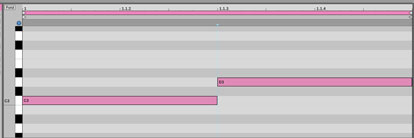What are Intervals
Basically an interval is the distance between two pitched notes.
For example the distance between C and D is a major second.
The reason why it’s important to understand all of the different intervals, is because:
1. They are the core building blocks, of chords and scales. Once you know intervals, it becomes a lot easier to build chords on the fly, this is very handy when working with other musicians. You’ll also know what notes need altering, in order to achieve a particular sound.
2. Knowing intervals will allow you to write music that represents certain moods and emotions.
For example if someone wants me, or I want to write an eerie song with lots of tension or suspense, I would write music that would utilise plenty of Tritones, Major Sevenths & Minor 2nds. Plenty of horror & ghost movies use these intervals. A classic example is the JAWS theme, which is simply a minor second repeating itself.
If I want to write music that is inspiring and uplifting, I would write melodies which contain lots of perfect fifths. For example the main Star Wars theme by John Williams.
How to work out intervals
Well it is pretty simple, we know we have 12 notes in the Western musical system.
That means we also have 12 intervals, within 1 octave.
If we use C as our “root”, root meaning our starting note, and we move up by 1 semitone, we land on C#, the distance between C and C# is called a minor second.
If we go from C to D we have moved 2 semitones, so we get a Major second.

This is a C – D showing a Major second interval.
C – E we get a minor third. Now you’ll see in the Interval Table below, that I have both D# and Eb

. This is because if we look at the piano below, we technically have the same note. Which note you use, would depend on the key you’re in.

For example, let’s say we are in the key of F#, a minor third from B is a D# not an Eb.
This is because when we are in a standard major or minor key, we cannot repeat the same note. We will cover this in more detail in future blogs.
It’s important to remember that this Interval chart starts on C, but can be translated to any note, or key.
For example, if we use G as our root note, B would be a major third, and Bb (B flat) would be our minor third.
If you would like to practice this on your own then I recommend checking out Tenuto.
https://www.musictheory.net/exercises/interval-construction
This exercise gives you a note then requests you to add the note which completes the intervals shown. If you’re new to this, then make sure you change the settings so it only asks you the 12 intervals that are on our chart.
Learn More Music Theory
If you’d like to quickly advance your music theory skills, then check out our Music Theory Lessons or Music Theory Course
FREE STUFF
If you would like this template for FREE, so you can take it everywhere you go, or would like to print it out. Then please click the link below!
